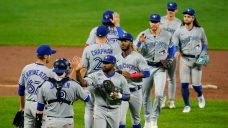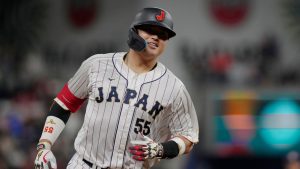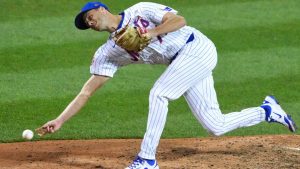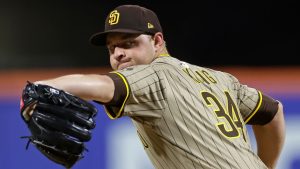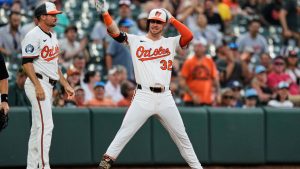BALTIMORE — Consider Santiago Espinal. He was playing in MLB’s All-Star Game just seven weeks ago after posting an .801 OPS through mid-June and seizing an everyday job as the Toronto Blue Jays' second baseman. He’s been a part-time player since the beginning of August, starting only 20 of his team’s 34 games over that span.
Consider Cavan Biggio. He lost his early-season platoon role opposite Espinal, missed over two weeks with Covid-19, spent another couple weeks at triple-A, and earned most of his playing time as a corner outfield or first base spot starter upon his return. He’s been playing just as often as Espinal lately, with 17 starts since the beginning of August.
Consider Whit Merrifield. He started all 84 games the Kansas City Royals played up until July 9 when he suffered a bone bruise fouling a ball off his foot, and led MLB in hits and games played since 2018 when he was acquired by the Blue Jays a little over a month ago. He’s started only nine of Toronto’s last 22 games.
Those are the three players Blue Jays interim manager John Schneider is considering at second base each night as he fills out his lineup card. And depending on recent performance, matchups, track records, offensive profile, defensive ability, base running, and just a little bit of gut feel, he’s liable to choose any one of them on any given night. That’s been the case over Toronto’s last five series, a span in which Espinal has started seven of Toronto’s games at second, Biggio has started five, and Merrifield has started four.
“It's a great problem to have. It's a great opportunity for everyone to be involved,” Schneider says. “I can't say enough about the way the three of them have gone about it. You're talking about a guy that's been here for four years, an All-Star this year, and a guy that leads the league in hits the last five years. So, it's kind of a unique situation where you have depth at the major-league level.
“Every day, the message to them has been, 'We are trying to win that game. And whoever's skillset fits that the best, that's what we're going to do. If you're not starting, you're going to be contributing in some way.’ And they've all been great. They're all willing to do whatever they need to do to win.”
That’s what ballclubs pushing for the post-season need in September — players quickly adapting to new roles, putting team before self. And it’s all players can ask for from their coaching staff in return — clear and open communication with regards to playing time and expectations. It’s not always so easy navigating that two-way street. And Schneider’s ease and persistence in having those conversations is an underrated trait he brings to Toronto’s managerial office.
Professional athletes with proven track records at the highest level such as Merrifield, Espinal, and Biggio won’t ever be thrilled with inconsistent playing time. But none of those three can say they’ve been caught off guard by it. The reality of Toronto’s position, battling nightly to hang on to the AL’s third wild card spot, is that Schneider has to ride hot streaks and react quicker to cold ones. And he’s said that directly to each of the principals involved in Toronto’s second base carousel.
“And all the guys are on board with that. We've talked with everyone about that and it's by no means to put more pressure on anyone. But it's a talented group all the way down. They understand that we're just trying to win every night no matter what the circumstance is,” Schneider says. “But at the same time, I think we're in a unique spot where a lot of different guys bring a lot of different skillsets. So, if they're not starting, they're maybe in there when we're trying to utilize what they're really good at.”
For Merrifield, those traits would be contact ability, speed, and defensive versatility. Need someone to lay down a bunt or put the ball in play against a tough reliever? He could be that guy. Need late-game wheels on the basepaths? He’s the club leader in sprint speed. Need someone to cover at second, anywhere in the outfield, or even first base after pinch-hitting or pinch-running for someone else an inning prior? He could do that, too.
For Biggio, it’s a similar situation defensively. His flexibility allows Schneider to use him at second, first, or a corner outfield spot as he tries to make puzzle pieces fit late in games. Offensively, Biggio provides a discerning, disciplined left-handed plate approach to contrast with the more aggressive right-handed hitters atop Toronto’s order. And with 25 steals in 26 attempts over the course of his career, plus the third-highest sprint speed on the team, his base-running shouldn’t be as slept on as it is.
For Espinal, the defence speaks for itself. He’s the best infielder of the three and the only one that can cover shortstop. And at the plate, he’s as prepared for battle as anyone. Espinal is averaging 3.9 pitches per plate appearance this season and has a top-20 contact rate. He worked an 11-pitch walk against DL Hall on Monday that led to a three-run inning and saw 26 pitches over four plate appearances in a game against the Chicago Cubs last week.
“He was the same way in the minor leagues,” says Schneider, who managed Espinal at double-A in 2018. “His line to me was always, ‘I'm ready to go. Whatever you need, whatever you need, whatever you need.’ So, I think embracing that change in role a little bit has allowed him to perform like he always has.’”
The role change for Espinal has certainly been abrupt. He went to the All-Star Game in mid-July as an everyday player and began ceding starts to Biggio only two days after he returned. That has something to do with the fact Espinal hit .218/.259/.273 over 116 plate appearances entering the all-star break from that day in mid-June when his OPS peaked at .801. But through it all, Schneider says Espinal’s approach hasn’t changed.
“He’s been totally professional. I've had talks with him. He's been the absolute consummate pro and a great teammate. He wants Cavan and Whit to do nothing but great things,” Schneider says. “He understands that, yeah, it is a change from the first, whatever, hundred games of the season. But him, like everyone, especially at this point in time, they want to win. And he's been nothing but professional about it. He's been great.”
Espinal’s skid has also coincided with Biggio looking more like the player he was through the first two seasons of his career, when he posted a 116 OPS+ over a 695-plate appearance sample. Since returning from the minors in late May, Biggio has hit .245/.335/.446 with a 13.7 per cent walk rate, which is more than the Blue Jays could ask from a versatile defender hitting in the bottom third of the lineup.
“He’s commanding the zone, getting on base, setting the table, and doing damage when he's getting good pitches to hit. He's really been consistent since he came back in May. And that's a huge, huge boost to our team and the way our lineup is constructed,” Schneider says. “We have a lot of really good, aggressive hitters. And I think it's nice to break up that string at times so a pitcher can't really fall into a rhythm of, 'OK, here's what I'm doing, here's what I'm doing.'
“We've seen it enough, too. When [Raimel] Tapia is in there, when Biggio is in there, it's a different feel. And a pitcher has to attack hitters a different way. And that usually leads to good things when those righties come back around the next time.”
Now, Espinal and Biggio aren’t in a straight platoon. If they were, Espinal would rarely play. The Blue Jays have made the fewest plate appearances against left-handed pitching (998) of any MLB club this season and the most against right-handers (4,168). Espinal has to face righties. And a right-handed starter isn’t a guarantee Biggio’s drawing in. Saturday, against Pittsburgh Pirates right-hander Roansy Contraras, Espinal was in the lineup with Biggio on the bench. Same thing Thursday against an Orioles tandem outing between righties Tyler Wells and Dean Kremer.
But the handedness splits each hitter has put up this season do suggest the Blue Jays ought to think about those matchups against tough relievers. And it’s something we’ve seen more of late, as Schneider has pinch-hit Espinal for Biggio against left-handers and Biggio for Espinal against righties in late-game spots over the last week.
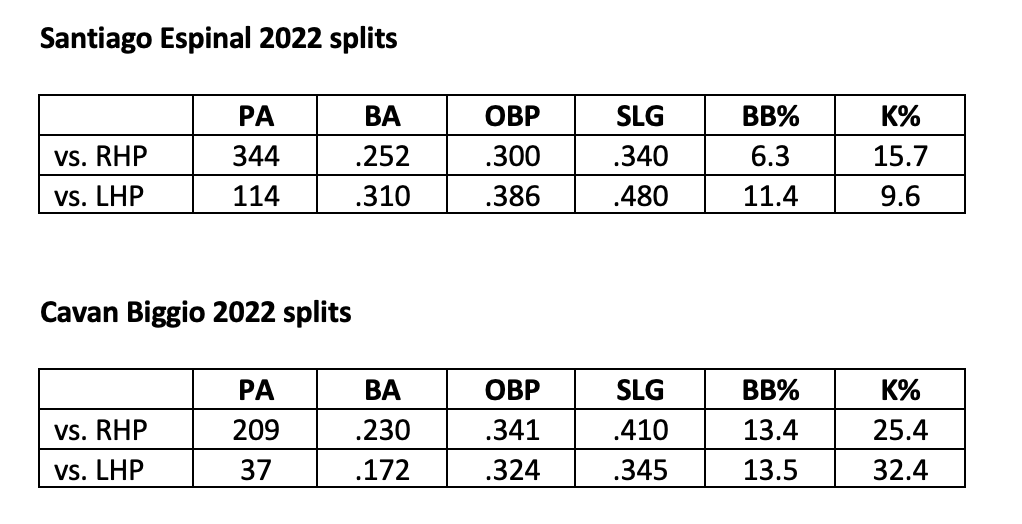
And, remember, there’s Merrifield, too. When the Blue Jays acquired the seven-year veteran at the trade deadline, club GM Ross Atkins said, “Whit is someone we see as an everyday player.” But that was before Merrifield hit .211/.274/.263 with a 21 per cent strikeout rate over his first 62 plate appearances with his new team. Baseball isn’t always a meritocracy. But it took only a couple weeks for Merrifield to play his way out of regular run.
Of course, that’s not the outcome anyone expected when the Blue Jays added Merrifield. And it’s not the player he’s been through the course of his career. Over the last three seasons with the Royals, Merrifield never had a strikeout rate higher than 14.5 per cent. So far with the Blue Jays, he’s striking out 20.3 per cent of the time.
It’s a decent bet that won’t continue. And things can change quickly this time of year, when the same urgent decision-making that’s decreased Merrifield’s playing time of late could just as easily increase it. He’s only a hot streak away. Or an injury to a regular away, like the one Lourdes Gurriel Jr. suffered running out an infield hit Wednesday, which brought Merrifield into a game off the bench.
In a September playoff push, when team results take utmost importance over individual ones, everyone has to do their part. Just ask Biggio, who’s seen the most plate appearances over Toronto’s last five series of all three players we’ve been talking about.
This time last year, Biggio was stuck in IL purgatory. He started a minor-league rehab assignment coming off a back issue in August, shut it down due to an elbow issue, then started another in September. He then spent a month partly with the triple-A Buffalo Bisons and partly with the Blue Jays watching games from his hotel room while on the club’s taxi squad.
He was finally activated to the major-league roster ahead of Toronto’s final homestand of the season as it made a last-breath playoff push. And on the first of October, facing big-league pitching for the first time in two months, Biggio went 3-for-4 out of Toronto’s nine hole and drove in the winning run of a tight game the Blue Jays couldn’t afford to lose.
A moment like that is coming for one of these three over the next four weeks. Could be Biggio again; could be the all-star-turned-part-timer, Espinal; could just as easily be Merrifield emerging from his funk. But, at this time of year, focusing on the who and not the what would be missing the point.
“I think with where we're at with guys stepping up and changing roles — you even think about a guy like Mitch White coming into the rotation, and Yusei [Kikuchi] being in the bullpen and having success the last couple of outings — I think that's huge,” Biggio says. “We’re all just taking a team-first mentality. Try not to be too aggressive and make an early, easy out. Take a team at-bat and try to get the pitcher to throw some pitches. Try to get some runs across any way we can.
“That’s the thing that I learned most last year — every pitch matters. Every pitch counts. And we have the ability to flip the momentum with any single guy in the batter's box. Where we are right now feels very familiar to last year. And last year, we missed it by a game. So, every pitch matters right now.”

